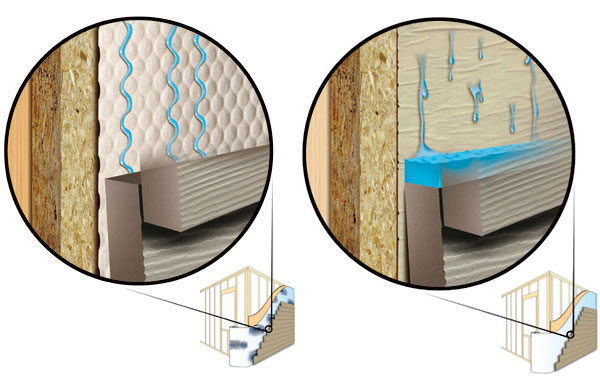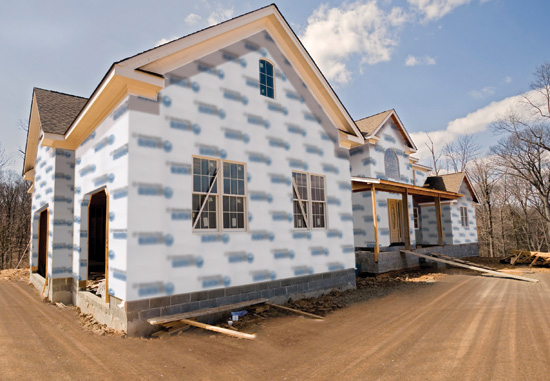Effective and Affordable House Wraps
Products fabricated in the form of cloth-like, non-woven water-resistant barriers use a patterned, grooved, dimpled, or otherwise textured surface to create a breathable barrier and improve water drainage within the wall. Rather than lie flat against the siding, the vertically textured material forms a thin air space that acts to encourage the channeling of any liquid that reaches the siding of the home to quickly drain out to the ground. These textured house wraps have achieved impressive drainage rates, with some demonstrating a 98 percent efficiency in liquid drainage.

Images courtesy of Kimberly-Clark
Textured house wrap (figure on left) protects homes by channeling water away from wall structures and to the ground. On non-textured house wrap (figure on right), water vapor condenses on house wrap and runs down, pooling on top of the siding or in the folds and wrinkles of the wrap. This moisture can lead to mold and rot of the wall assembly.
As can be seen in the above comparative illustration in which house wrap is attached to oriented strand board sheathing on top of 2x stud framing, textured house wrap is superior to non-textured in terms of water drainage. The textured material channels water away from the wall structures to the ground, while water vapor condenses on non-textured house wrap and runs down, pooling on top of the siding or in the folds and wrinkles of the wrap. This trapped moisture can lead to mold and rot of the wall assembly.

Photo courtesy of Kimberly-Clark
Next-generation house wraps resist water and air intrusion into the structure and allow water vapor to escape from the wall cavity, leading to more energy-efficient, sustainable homes.
While this level of performance may signal a product that is prohibitively expensive, that is not the case. Textured house wrap can be a mid-price product when the manufacturer has a firm control of costs, particularly when the product is fabricated in the manufacturer's own mills—an arrangement with favorable implications not only for pricing but for quality control as well.
Foam Sheathing and House Wrap
Foam sheathing is not an air barrier or a weather barrier. While foam sheathing may be an adequate, low-cost method for achieving the R-values required by the 2012 IECC, because it does not provide an effective water-resistant barrier, it fails to protect the structure in a comprehensive manner. Even when properly installed and taped, foam sheathing lacks the shingling effect necessary to keep water from seeping through the edges of the tape and into wall assemblies. Once those wall assemblies get wet, the ambient humidity both inside and outside the structure can make them tough to get dry, resulting in rot, mold, and eventual structural failure—all problems that have resulted in skyrocketing insurance claims that continue to plague builders. Some consider it best practice to install an effective WRB that can provide weatherization and breathability benefits that help maintain the as-constructed R-value of the home insulation. The right, properly installed house wrap can provide a superior air barrier to foam sheathing by itself, which can expand and contract in the heat and cold, causing tape seams to fail, which allows the air barrier to be broken.
As the building community becomes more aware of the advantages, the use of house wraps will increase in the coming years. Driven by building codes, regulations governing building envelope systems, and the move to construct energy-efficient homes and upgrade existing insulation systems, house wraps in fact are expected to see a surge in growth globally, according to consulting firm Frost & Sullivan, in its recent report entitled “Analysis of the Global House Wraps Market.” The firm found that the house wraps market earned revenues of $696.4 million in 2013 and estimates this to reach $1.05 billion in 2018, with user preference for the non-perforated house wraps projected to increase during the forecast period. Manufacturers providing a wide range of products with optimum price-performance stand to gain as do those with “efficient after-sales services, including on-site support, extended warranty programs, and product workshops will provide opportunities for market participants to speed up customer acquisition.”3 The study goes on to state that “the energy to manufacture house wrap for a single house is only 1.2 to 1.8 million Btu depending on the type of polyolefin used,” and that “compared to the energy savings resulting from the application of house wrap, the average 'pay back' period ranges from only 7 to 54 days.”
Specification Considerations
High-performance house wraps share several characteristics. They demonstrate high levels of air resistance, water resistance, vapor permeability, and durability both during and after construction. When choosing the right house wrap several factors should be considered:
• Climate – The amount of annual rainfall
• Exposure – Amount of overhang, altitude, trees, and building proximity to the structure, even the geographic orientation of the wall
• Cladding type – Wood, insulated vinyl, fiber cement, brick, stone, stucco, etc.
With more than a few brands on the market, it is important for architects to complete their due diligence. At the very least, how the product rates on industry standard tests should be closely examined, particularly those of the American Society for Testing and Materials (ASTM), whose more than 12,000 standards are in operation globally, and the International Code Council (ICC ), whose I-codes provide minimum safeguards for people at home, at school, and in the workplace. While generally speaking house wrap products will undergo such testing, a word of caution is in order. It should be noted that these tests are performed on small samples of the test material, not on real-world buildings in actual field conditions, making apples to apples comparisons difficult.









